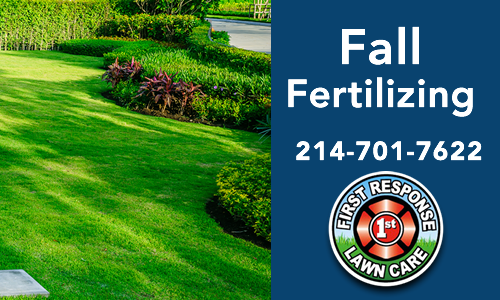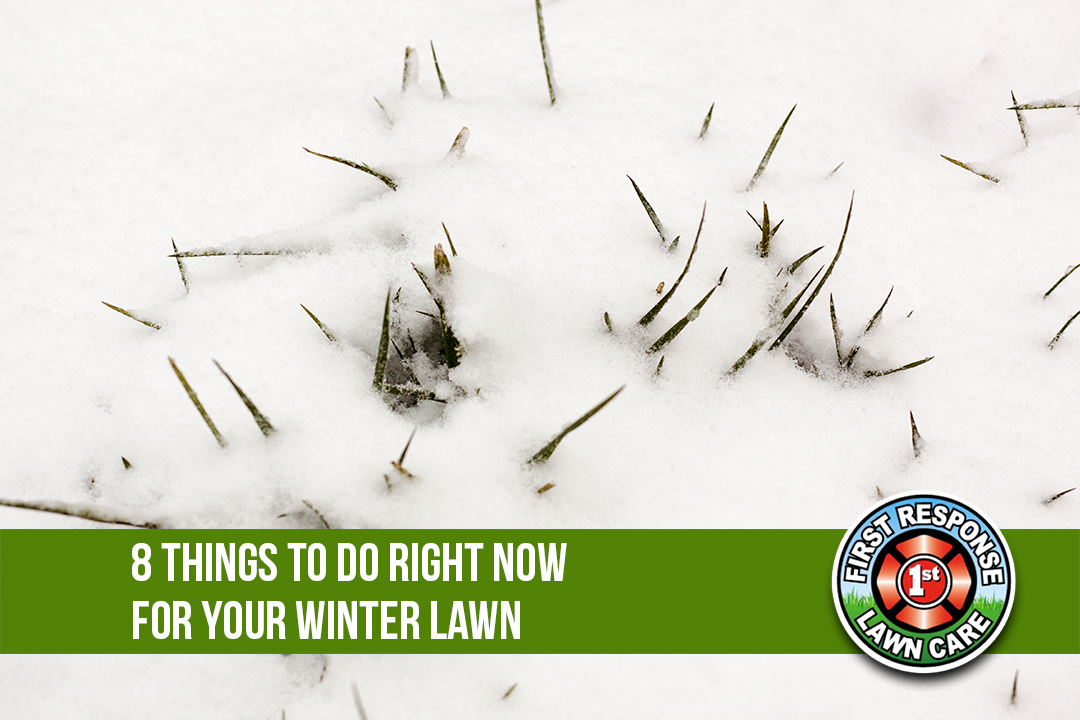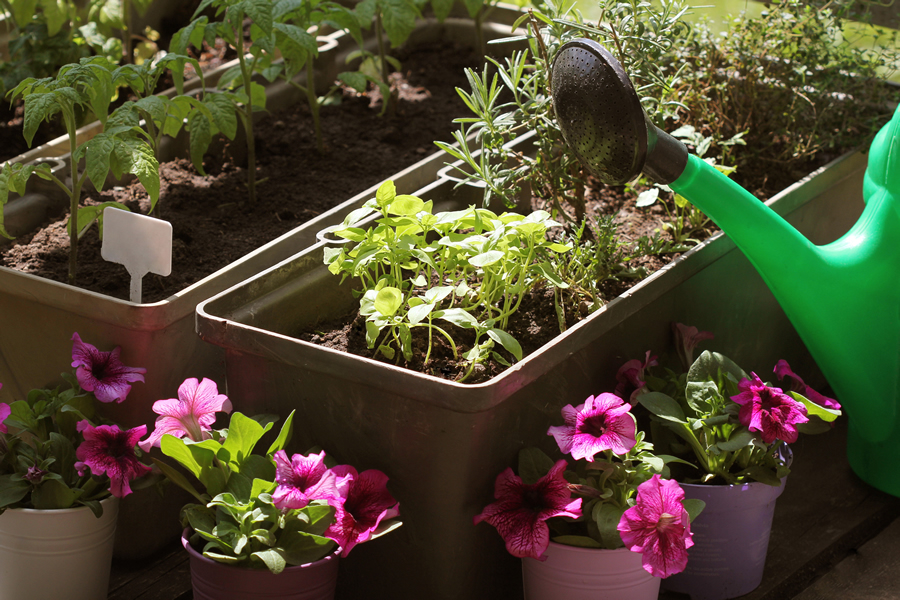
by admin | Sep 24, 2019 | Fertilize Treatments Rockwall, Herbicides
Autumn is the right time of year to nourish your yard!
Fall is here and it’s time to fertilize. Why now? Taking the time to fertilize in the fall will strengthen your plants’ and lawn’s roots, giving them a strong base on which to thrive next spring.
The first thing to understand about fertilizer is the formula, which is represented by three numbers, such as the common 5-10-5. The first number represents nitrogen, which promotes lawn blade and foliage growth; the second number stands for phosphorus, which helps root growth; and the third for potassium, which promotes cell function and absorption of trace elements. But what do you fertilize? When? And with what? Let’s start with your lawn.
During fall, September is the best time to fertilize your lawn. Grass is recovering from a long hot summer and may be coming out of a drought-induced dormancy, so you’ll want to give your lawn a shot of nitrogen to push blade growth. A fertilizer with a formula of 20-8-8 will get it growing again. Always follow the manufacturer’s recommended rate of application. Some people treat weeds and insects at this time, but I think that unless there are signs of trouble or a history of problems, don’t apply anything but fertilizer. While this fall lawn fertilizer dose is important, an application at the end of October or early November is essential. At that time, apply a fertilizer with a formula of 13-25-12. The push of phosphorus will stimulate root growth through November and even into early December. By helping roots grow before winter sets in, you are insuring that the lawn will green-up quicker in the spring and become more resistant to disease and draught.
With the lawn taken care of, it’s time to consider plants. By now, perennials are starting to fade but they will benefit from 0-20-0 super phosphate fertilizer scattered around the plants at recommended doses and lightly cultivated into the soil. Next spring you’ll have stronger plants with more flowers.
Fall is also a great time to fertilize shrubs and trees. Sll trees and shrubs benefit from fertilizer, because most of them are located in mulch beds that use up nitrogen as they decompose. In addition, every fall we rake leaves off these beds, depriving plants of the nutrients that decomposing leaves would traditionally release. To compensate, I recommend applying one to three pounds of slow-release nitrogen per 1,000 square feet of bed and cultivating lightly. (To figure out the exact amount of fertilizer you’ll need, calculate the square footage of your beds and consult with your local garden center.) Fertilizing trees in late September and early October promotes root growth. These nutrients will still be in the soil come spring when plants start to grow. If you have a tree or shrub that does not flower well, a dose of super phosphate will help promote flower growth. However, if the plant is not located in the right spot, all the super hosphate in the world won’t make it flower.
Fall is also the time to plant bulbs. Use super phosphate to promote root growth, insuring strong flowering in the spring. Some people recommend using bone meal when planting bulbs but beware, this attracts rodents who eat both the bone meal and the bulbs.
As you can tell, the basic goal of fall fertilizing is to promote root growth. When you have strong roots, you have healthy plants with numerous flowers. So push those roots!
If all of this sounds complicated and you’d rather leave it to the professionals, call First Response Lawn Care at (214) 701-7622.
We offer a 7 step program to feed and control your lawn weeds.

by admin | Jan 24, 2019 | Fertilize Treatments Rockwall, Gardening Tips, Lawn Aeration Rockwall, Lawn Care Royse City, overseeding ryegrass rockwall, Pre emergent Service Fate TX, Shrub Trimming Caddo Mills, Weed Control Fate, Weed Control Royse City, Winterizing, Winterizing Your Lawn
Here are 8 Things To Do Right Now For Your Winter Lawn. Texas’s warm humid climate and rich soil, is ideal for plant life. Gardens here show evidence of that.
With the first official day of Spring still over a month away, your attention may be focused mostly indoors. Even in the cold winter months, however, our lawns and gardens have specific needs. What may look dead and brown but is teeming with life just underneath the surface.
In order to reduce pests and ensure that your plants and grasses will thrive as the weather warms up, your Texas winter gardening regimen should include these essential steps.
TIPS FOR SUCCESSFUL TEXAS WINTER GARDENING.
Apply Pre-emergents
Now is the time to apply your pre-emergent on lawns and grasses to prevent the germination of weed seeds. The window of opportunity is open right now. Corn gluten meal is a great organic approach, but other herbicides can be purchased at your local nursery or home improvement store. Pre-emergent is a small step that yields BIG dividends in spring and summer.
Fertilize
If you haven’t done so already, fertilize all established trees and shrubs (except azaleas and camellias), and feed perennial bulbs. This can be done simultaneously with the pre-emergent. Your compost pile is perfect for this use, or check with your local garden center for recommendations.
Watch the weather
Historically, the coldest days of the year fall in the month of February. This does not come as great news to those of us yearning for the warmer weather, but gardeners should be on watch for a potential freeze all the way into the month of March. Make sure to water the roots well, and cover plants if temperatures fall below 32 degrees.
Pruning
This is the best time to prune shrubs, trees, and roses, but wait to prune spring flowering trees until after they bloom. Crepe Myrtles are the exception to this rule. Experts advise that crepe myrtles should never be pruned or can be pruned very gently.
Mowing
Mow your lawn once this month. This will allow the sun to reach the roots.
Clean up
Rake any fallen leaves, for the same reason. Grass roots need sunlight to germinate and begin the new growth cycle. Be sure to remove all debris and other encumbrances to growth. These leaves and other lawn debris can be put into the compost bin for later use as fertilizer.
Weeding
Dig weeds out by hand. There may only be a few, but soon they will become legion. Tackle the small job now, to avoid a larger one later.
Plant bulbs
Now is the time to plant later blooming bulbs and tubers such as dahlias, elephant ears, caladiums, and calla lilies. This is also the perfect time to plant strawberries.
Yes, it is cold outside. But if you want to have a beautiful landscape when spring comes, the time to begin is now.
Questions? Contact First Response Lawn Care by clicking the link below to ask about our expert services in all these areas!
Contact First Response Lawn Care Today!

by admin | Oct 19, 2018 | Fertilize Treatments Rockwall
Herbicides Rockwall
First Response Lawn Care has one mission – to give you a healthy lawn year round. By combining our 7 step program with good mowing and watering practices, your lawn should stay healthy and green all year long.
Autumn is the time for herbicides Rockwall, Royse City and surrounding areas. It’s also time for overseeding and other preventive maintenance to keep your lawn looking good into winter and onto Spring.
Let’s start with dethatching. Thatch, a mat of yellowish dead grass that can block air and moisture, needs to be removed. If you slacked on the dethatching in spring, now is the time, but don’t go at it too aggressively.
If you need to reseed, use proprietary turfgrass seed, available at nurseries, on the Web, and from landscape-supply houses. Turfgrass breeders constantly improve their seed, and many produce specific regional types. While this seed is more expensive than what’s sold at home centers, it’s also more vigorous. Cira quotes the old adage that a cheap tool is an expensive tool. “You might pay a few dollars more for a proprietary seed, but the results are tremendous, and you don’t have to keep constantly reseeding,” he says.
To seed a bare area, till the soil, apply the seed, and then cover it with a thin layer of lightweight, compost-soil/peat-moss blend. Then be sure to keep it moist. Once the seeds get dry, they’re dry for good.
Remove leaves‚ they block sunlight just when grass needs as much light as possible for photosynthesis and root growth. Grass should go from vigorous growth into winter, not enter it weak and underfed.
Even when the lawn is dormant, it needs to eat. Don’t fall at the last hurdle. We can put the lawn to bed with winterizer to promote root stability, cold-weather hardiness, and disease resistance, so you get great results come spring. The lawn greens up much quicker with fertilization.
We can give you a football worthy lawn to impress your friends and family for the holidays. Call us to get started on your Pre-post emergent.

by admin | Sep 14, 2018 | Aeration, Fertilize Treatments Rockwall
September could very well be the best month of the year to fertilize your lawn. We know you’ve heard this before in other months, but this is THE MONTH for fertilization. Here are our top tips for September lawn maintenance in Texas.
Dethatch Your Lawn
A thin, half-inch layer of thatch is normal and healthy for a lawn, but thatch that’s deeper than 1 inch should be removed as it prevents air, light and water from reaching the turf’s root zone. As thatch accumulates, there is a tendency for root growth to occur primarily in the thatch layer rather than the soil. This may result in a weakened, poorly rooted turf that is prone to stress injury. Thatch also makes an excellent breeding ground for harmful insects and disease organisms. For more information about dethatching, call First Response Lawn Care at (214) 701-7622, your lawn care service provider in Rockwall, Caddo Mills, Royse City, Fate, Rowlett, Forney, Heath, Sachse, Wylie, Lavon, Garland and surrounding areas.
Plant
Plant St. Augustine sod by mid-month to allow time for deep root growth before the first freeze. Bermuda seed should also be sown no later than mid-September, but sod can be planted later in month, if needed.
Aerate Your Lawn
After detaching your lawn, it’s a good idea to follow through with aeration. Aerating your lawn allows more nutrients and water to reach the grass root zone. Fall is a great time to do it as grass plants are beginning to store food for next spring.
These are only a few things you can do during September to keep your lawn healthy and strong for the pending winter season.
Apply Pre-emergent Herbicide
Apply a pre-emergent herbicide in September to prevent winter grassy weeds such as annual bluegrass, rescue grass and rye. (Don’t use if you’re over-seeding your turf.) Gallery products prevent annual broad-leafed weeds.
Pre-emergents need to be applied before the weeds actually sprout and start growing. You can apply them on the same day, then water them both onto the soil’s surface at the same time, but do not try to mix them in the fertilizer spreader. Make two separate passes across the lawn.
First Response Lawn Care can take care of all your lawn care maintenance aeration, fertilization and more in Rockwall Texas and surrounding areas.

by admin | Jul 27, 2018 | Fall Vegetable Garden Prep, Fertilize Treatments Rockwall, Herbicides
August is the time to plant Fall vegetables. Set out transplants of broccoli, cauliflower, and collards. Sow seeds of beets, lettuce, English peas, spinach, turnips, and mustard.
The soil in your garden bed should be loose and easy to work. If it is not, add large amounts of compost or other organic amendments. You can use a tiller or a shovel to work the dirt.
Vegetables don’t have to have their own bed. You can intermingle them among established ornamental plants in your flowerbeds, or grow them in containers. The great thing about using containers is that you can move them at will to catch the proper amount of sunlight.
Vegetables do need lots of sunlight, generally at least six hours of direct sun. Those with edible roots – beets, carrots and radishes – plus broccoli and cauliflower can get by with an hour less sun. And leafy plants such as lettuce or spinach do better with protection from the hot afternoon sun.
Add a slow-release fertilizer if you haven’t fed the bed during the year. If you have, don’t bother. Organic fertilizers such as cottonseed meal work well, though there are plenty of nonorganic fertilizers available. One tip: Before going to the garden center, measure your bed; that way, you’ll know exactly how much to buy, as packages list how many square feet they cover. As always, follow package directions.
Make sure the soil is moist before you plant seeds, as it aids germination. Also, regular watering after you plant is vital to ensure that the August heat doesn’t burn your crop.
Experienced gardeners recommend fertilizing again a few weeks after planting. Just water in the fertilizer around the base of each plant.
Fall will be the time to sow cold-season crops such as lettuce, broccoli, cabbage and cauliflower. Don’t plant seeds of those until early September.
When we reach October, most people will be longing for cool weather. But if you plant tomato transplants now, you’ll be hoping the hot days continue.
•Tomatoes need hot weather to set fruit. Aug. 1 is a bit late to be assured that the fruit has time to mature before first frost, which arrives on average in mid-November.
•Transplants will give you the head start you need.
•Texas AgriLife Extension Service has put together a list of tomato varieties that do well in our area. Don’t expect to find most of them at your local nursery or garden store. Spring is high season for tomato transplants.
•The recommended cultivars: ‘Bingo’, ‘Carnival’, ‘Celebrity’, ‘Sunpride’, ‘Sunchief’, ‘SunLeaper’, ‘Amelia’, ‘Solar Fire’, ‘Florida 47’, ‘Florida 91’, ‘Top Gun’, ‘Porter’, ‘Roma’, ‘Red Cherry’, ‘Yellow Pear’ and ‘BHN444’.
Water can make the difference in whether your vegetable crop succeeds or fails. Too much water – rarely a problem in Texas – can drown plants; too little, and they die.
The most recommended method, both for the plants and for your pocketbook, is to water deeply, but only when needed. Stick your finger into the soil near the plants. If you feel moisture a few inches down, you can wait to water. If dry, water enough to get the soil moist at least 6 inches deep.
The Web site www.learn2grow.com explains five methods of watering vegetables:
Drip irrigation: Delivers precise amounts of water directly to plant roots. Can be time-consuming to set up initially. Saves water costs in the long run.
Trench irrigation: Used when vegetables are planted in rows. Fill a trench that you dig alongside your row vegetables with water. The water will penetrate deeply into the root zone.
Moat irrigation: This close relative of trench irrigation is especially useful when crops are planted on hills. Dig a moat around each plant (square or round) and fill the moat with water when plants need moisture.
Soaker-hose irrigation: Like drip irrigation, soaker hoses deliver water directly to roots. They are not as precise, though they are usually cheaper and easier to lay down.
Overhead misting: Especially for cool-season vegetables. A gentle soaking from a hose-end nozzle allows water to slowly seep in. Time-consuming, though.
First Response Lawn Care can help you with irrigation, fertilization and much more if you need a helping hand with your lawn and garden!





